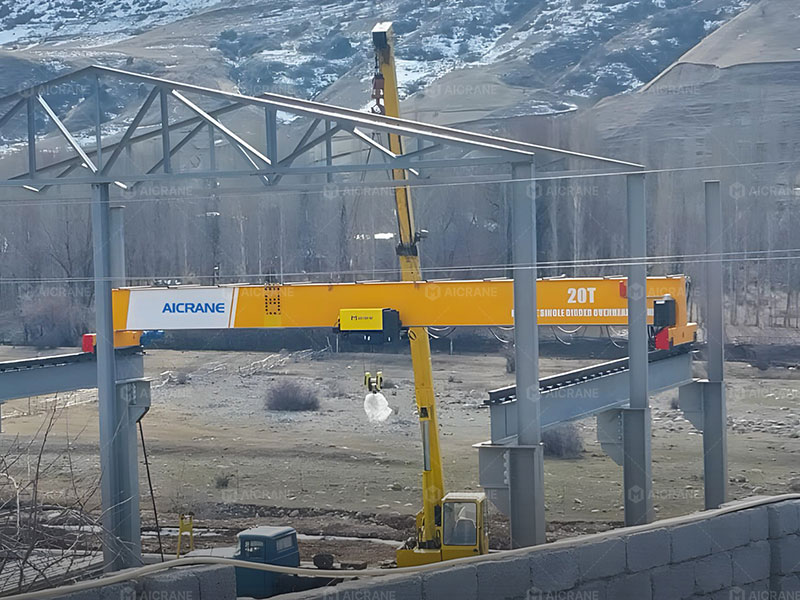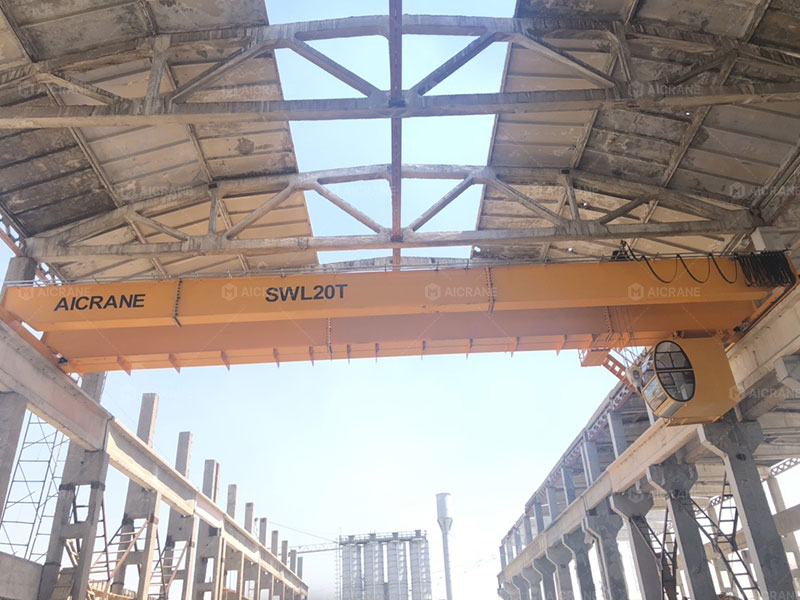When choosing an overhead crane with a 20-ton lifting capacity, one of the first and most important design decisions involves selecting between a single girder and double girder configuration. Each type has unique advantages and limitations, especially when working at this medium-to-heavy-duty capacity level. This article explores the key differences between single girder and double girder 20 ton overhead cranes in terms of design, performance, cost, installation, maintenance, and suitability for different applications.

Understanding the Basics
What Is a Single Girder Overhead Crane?
A single girder overhead crane consists of one main bridge girder supported on either side by end trucks. A trolley and hoist are mounted underneath the girder and travel along its bottom flange. The hoist may be an electric wire rope hoist or an electric chain hoist, depending on the design.
What Is a Double Girder Overhead Crane?
A double girder overhead crane features two parallel bridge girders, with the trolley and hoist riding on rails mounted on top of the girders. This design provides greater lifting height, better stability, and higher load capacities.

Key Comparison Areas
1. Structural Design and Configuration
Single Girder:
-
One main beam spanning the runway.
-
Lighter overall structure.
-
Hoist hangs below the beam, limiting lifting height.
-
Typically uses a top-running or under-running hoist.
Double Girder:
-
Two main beams with a trolley that rides on top.
-
Heavier and more robust structure.
-
Allows for maximum hook height.
-
Designed for top-running trolleys.
Conclusion: For applications where headroom is limited or lifting height isn’t a top priority, a single girder overhead crane may suffice. However, for maximizing vertical space, a double girder design is superior.
2. Lifting Height and Hook Approach
Single Girder:
-
Limited lifting height due to the under-hung hoist.
-
Hook approach is slightly restricted from the end.
Double Girder:
-
Higher lifting height since the hoist sits on top of the bridge.
-
Better side and end hook approaches.
Conclusion: Double girder cranes offer better lifting geometry, especially valuable in facilities with limited overhead space or when tall loads must be lifted high.
3. Load Handling and Distribution
Single Girder:
-
Suitable for lighter applications or consistent, repetitive loads.
-
More deflection under heavy loads.
Double Girder:
-
Better distribution of the 20-ton load across two beams.
-
Less deflection and greater structural rigidity.
-
Capable of handling more demanding or off-center loads.
Conclusion: For handling full-capacity loads more efficiently and safely, the double girder design offers better stability.
4. Cost Considerations
Single Girder:
-
Lower upfront cost.
-
Fewer materials and simpler design.
-
Less expensive installation and maintenance.
Double Girder:
-
Higher initial investment due to heavier steel structure and longer fabrication time.
-
Increased cost in terms of components and installation.
Conclusion: When budget is tight and the use case does not demand advanced features, a single girder 20-ton crane can be more economical.
5. Installation and Building Requirements
Single Girder:
-
Easier and faster to install.
-
Lighter load on runway beams and building structure.
-
Ideal for smaller workshops or existing buildings with limited support.
Double Girder:
-
Requires more robust support structures.
-
Heavier components mean more complex installation.
-
Best suited for purpose-built industrial facilities.
Conclusion: Consider the capacity of your building structure. If structural support is a concern, single girder may be more feasible.
6. Maintenance and Accessibility
Single Girder:
-
Fewer components make for simpler maintenance.
-
However, the hoist mounted underneath may be harder to access in certain configurations.
Double Girder:
-
Trolley and hoist are more accessible on top of the girders.
-
Easier to perform maintenance at height with catwalks or platforms.
-
More components require a slightly higher maintenance effort.
Conclusion: Double girder bridge cranes may require more proactive maintenance, but accessibility for service work is generally better.
7. Customizability and Add-ons
Single Girder:
-
Limited space for add-ons such as walkways, maintenance platforms, or cabs.
-
Less flexibility for advanced automation or heavy-duty duty cycles.
Double Girder:
-
Easily supports additional features: walkways, lighting, cab control, cameras, sensors.
-
More scalable for automated or high-duty cycle environments.
Conclusion: If future expansion or automation is planned, a double girder system offers greater flexibility.
8. Applications and Industry Use Cases
| Application Type | Single Girder 20 Ton Crane | Double Girder 20 Ton Crane |
|---|---|---|
| Fabrication Shops | ✅ Suitable | ✅ Suitable |
| Steel Coil Handling | ❌ Not Ideal | ✅ Preferred |
| Heavy Equipment Manufacturing | ❌ Limited | ✅ Ideal |
| Warehouses | ✅ Compact spaces | ✅ If high lift needed |
| Shipyards / Power Plants | ❌ Inadequate | ✅ Industry standard |
Conclusion: Double girder cranes are more versatile in terms of industries and challenging lifting applications.
When to Choose Single Girder for 20 Tons?
-
Budget constraints are a primary factor.
-
Your building structure can’t support the weight of a double girder system.
-
The lifting height requirement is moderate.
-
You have limited space and low ceiling clearance.
-
You need a compact crane for relatively repetitive or moderate-duty operations.
When to Choose Double Girder for 20 Tons?
-
Your facility demands maximum lifting height and hook approach.
-
You require advanced features or future automation.
-
The crane will be used in continuous, heavy-duty operations.
-
You are handling oversized, awkward, or very tall loads.
-
Safety, stability, and durability are top priorities.
Final Thoughts: Tailoring the Right Design to Your Needs
Selecting between a single girder and double girder overhead crane at the 20-ton capacity level comes down to balancing cost, operational needs, and space limitations. While single girder cranes are often more affordable and easier to install, double girder cranes offer unmatched performance, flexibility, and lifting height.
For some customers, the initial savings of a single girder crane may be worthwhile. But for others, especially those running demanding, high-cycle operations, the long-term advantages of a double girder design – greater lifting height, safety, and customization – will justify the higher upfront investment.
How We Can Help
At Aicrane, we provide both single and double girder 20-ton overhead cranes tailored to your specific operational and site requirements. Whether you need a cost-effective single girder crane for general lifting or a robust double girder system for heavy industrial use, our team offers custom design, professional consultation, and full after-sales support.
Contact us today to get expert guidance on choosing the right crane system for your facility.